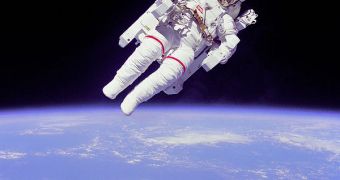While spending time aboard the space shuttles or the International Space Station (ISS) can be an amazing experience, the work that needs to be done on the sides can be excruciatingly difficult. And we're not just talking about the training that would-be astronauts undergo before they fly to space, but also about the tremendous amount of effort they need to make upon their return. This is especially true for people coming back from six-month missions to the ISS, who have the most to endure.
Among the most commonly met problems of returning astronauts, experts include dizziness, difficulties standing, walking or turning, as well as other similar side-effects, all caused by balance issues that stem from being subjected to gravity once again. Now, scientists at the National Space Biomedical Research Institute (NSBRI), led by expert Dr. Jacob Bloomberg, are working on new therapies that would ensure a faster adaptation to the Earth's gravity for those returning from space missions.
The group says that its work could easily extend beyond uses in space exploration. Scientists argue that the elderly, or people with balance disorders, could also benefit from therapies that it will design in the near future. One of the preliminary steps was the development of a treadmill that was mounted on a multi-directional base. This base can move and tilt according to the experts' demands, effectively simulating balance disorders. The Adaptability Training System also features a screen showing a room, or another setting, through which the astronaut/patient walks. When the treadmill tilts in one direction, the screen tilts in the opposite one, creating a feeling of imbalance, the experts say.
“At first, people find it difficult to walk on the treadmill since its movement and images are out of sync. But over time, they learn to walk on it efficiently. We call this concept 'learning to learn,'” Bloomberg, who is a senior research scientist at the NASA Johnson Space Center Neurosciences Laboratory, and also an NSBRI Sensorimotor Adaptation Team associate team leader, explains. “In space, information from the sensory systems is different, particularly when you take away gravity. The brain reinterprets that information, makes adjustments and allows you to do the activities you need to do in space. The down side to that is when you return to Earth, the sensory systems are not used to a normal gravity environment,” he explains.
“For astronauts, the sensory systems are working just fine but the information is being interpreted differently. For the elderly, it could be a combination of issues: the sensory systems may be deteriorated or the information may not be integrated by the brain as well as before. We might use this training to improve some of the deficits that the elderly might experience. There are definitely applications in the clinical world in terms of fall prevention with the elderly population,” he adds.

 14 DAY TRIAL //
14 DAY TRIAL //